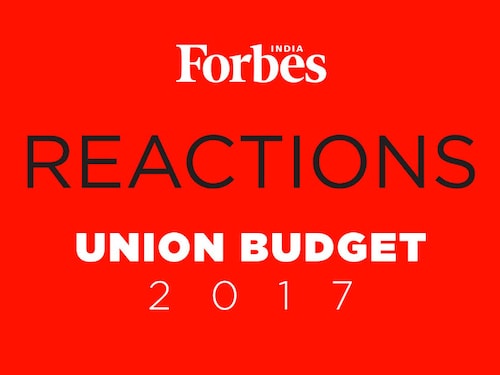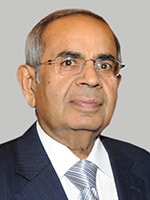India Inc reacts to Budget 2017-18
The Finance Minister Arun Jaitley presented the Union Budget before the Parliament, on February 1, 2017. Here are some reactions from members of corporate India


The Finance Minister Arun Jaitley presented the Union Budget before the Parliament, on February 1, 2017. Here are some reactions from members of India Inc. Adi Godrej, Chairman, Godrej Group (Pictured left)
Adi Godrej, Chairman, Godrej Group (Pictured left)
This was a very good budget that was growth-oriented. The measures announced by the Finance Minister, including the lowering of income tax, will help boost consumption. With remonetisation working well and GST on the anvil, private sector investment should also revive shortly. Kiran Mazumdar-Shaw, Chairperson, Biocon
Kiran Mazumdar-Shaw, Chairperson, Biocon
The budget was well-balanced. After demonetisation was implemented and with GST slated to come into effect soon, the finance minister stayed away from announcing any big-bang reforms. But there were a lot of positives like the impetus to small businesses and startups in the form of lower taxes, and focus on rural areas and agriculture. Detailed allocation of the proposed infrastructure spending announced in the budget needs to be examined in granularity.  Glenn Saldanha, Chairman and Managing Director, Glenmark Pharmaceuticals Ltd
Glenn Saldanha, Chairman and Managing Director, Glenmark Pharmaceuticals Ltd
Overall, the Union Budget 2017 is a step in the right direction. While it has focused on economic reforms and liberalisation of the economy, it has also allocated funds to bring more irrigation, roads, electricity and sanitation to rural India. Even though the economic survey paints a sober picture for ’16-17 primarily due to a weaker second half, the budget provides the necessary impetus to sustain GDP growth at over 7%. Lowering tax on MSMEs is a welcome step that would provide a much needed fillip—by creation of jobs and putting more money in their pockets in all sectors including pharmaceuticals. The government has shown its clear intent towards fast-tracking inflow of FDI, and the scrapping of FIPB is a notable step that would go a long way in supporting the objective of ease of doing business. Additionally, the government’s impetus to reduce the borrowing cost and increase access to credit will surely help businesses to grow. We see the biggest ever allocation to the infrastructure sector which would benefit all sectors, including the fast growing pharmaceuticals. The finance minister reiterates his commitment to keep current account deficit and fiscal deficit under control GST implementation as soon as possible. Gautam Adani, Chairman, Adani Group
Gautam Adani, Chairman, Adani Group
I see this year’s budget in the backdrop of the fragile global economic condition and continuing uncertainty. Amidst this backdrop, India is considered to be a bright spot by international agencies including IMF, UNCTAD, etc.
The government has clearly shown its resolve in continuing to provide resources to rural India on three dimensions viz. agricultural front—by enhancing the crop insurance allocation and Model contract farming law plus targeting higher credit availability for the sector on the rural employment front, by enhancement of over 26% to MNREGA and on Rural Infrastructure front—a massive push to PM Gram Sadak Yojna, PM Awaas Yojna, rural electrification allocation as well as dairy processing infrastructure fund.
These measures will enhance the public spend on the rural front and help the government fulfill its target of enhancing quality of life for the underprivileged in rural India in combination with increased allocation on Swachh Bharat, skill enhancement, etc.
The other two notable initiatives are:
a) Integrated rail, road, airport and water way infrastructure with a total spend of Rs 2.41 lakh crores keeping in focus redevelopment of railway stations, 700 km of additional railway lines, airport upgradation in tier-2 cities with PPP model, 2000 km of coastal road linking with major cities and ports and development of multi-modal logistics parks.
b) Affordable housing by assigning ‘infrastructure’ status.
All these initiatives are taken with adherence to fiscal discipline which shows the government’s ability to balance growth with prudence.
All in all, growth for the rural and underprivileged–build-up of infrastructure in urban India, affordable housing, fiscal prudence and most importantly more money in the hands of honest tax payers. A refreshing approach towards growth through prudent budget measures.
 Mukesh Butani, Managing Partner, BMR Legal
Mukesh Butani, Managing Partner, BMR Legal
The budget has an inclusive agenda with more good, less bad and no ugly. The Finance Minister has presented a balanced and well-thought budget keeping in mind the theme ' Sab ka vikas sabka sath ', though, I do see an undercurrent of a move to redistribute income, by alleviating the pain of citizens affected by the demonetisation and a corresponding levy of surcharge on high net worth individuals and large businesses. He has been modest on the estimate of the fiscal deficit of 3.2 percent walking the middle path, with a commitment to study the NK Singh panel on FRBM. The proposal to abolish FIPB is a bold move, expected to reduce M&A timelines, create new investment opportunities for foreign investors. The economic secretary, of course, cautioned that the existing FDI limits on defence etc. and FDI in sectors that entail national security shall be subjected to controls. An interesting announcement has been the creation of an integrated PSU oil major, this could lead to consolidation of existing oil PSUs and possibly look at international markets for funding and/or possibility of leveraging on larger balance sheet for bidding for upstream assets, given India’s thirst for oil.
The Finance Minister has presented detailed statistics about the demographics of individual and corporate taxpayers justifying overall tax rate changes, revenue considerations and delay for an across the board tax reduction. On the tax side, whilst there have been no big announcements, some proposals have been made to boost the foreign investment and provide relief to middle-class individuals and MSMEs. Tax proposals to political contributions taxability is suggestive of the bold moves the government is keen to pursue. A proposal on the concessional rate of 5 percent on external commercial borrowings up to 30/06/2020 is a welcome move. Similarly, the proposal to exempt certain categories of Foreign Portfolio Investors from indirect transfer provisions reiterates government commitment to provide a non-adversarial tax regime. A proposal has been made to reduce the corporate tax rate to 25 percent for MSMEs having a turnover up to Rs 50 crore for individuals some relief has been provided for income earners up to Rs 5 lakh.
An unexpected announcement in the budget is the proposal to reduce holding period from 3 years to 2 years for long-term gain on transfer of immoveable property. This is going to boost the investment in the real estate sector. Further, keeping up to expectations, proposals have been made to digitalise the payments including no deduction for expenditure above Rs 10,000 in cash. On the indirect tax side, no tinkering has been done with the excise duty and service tax rates, possibly the Finance Minister would make a one-time increase at the time of implementation of GST.
Arvind R Vohra, Country CEO & MD, Gionee India
We are positive that the government’s increased allocation and incentives in schemes like M-SIPS and EDF will provide the necessary push to the mobile and internet manufacturing economy . Also, the allocation of INR 10,000 crore in BharatNet provides the much needed boost for the penetration of Digital India into the rural segment, and for strengthening the consumption of smartphones. Brotin Banerjee, MD & CEO, Tata Housing
Brotin Banerjee, MD & CEO, Tata Housing
Infrastructure status to affordable housing comes as a landmark announcement for the consumers and the real estate industry. A long-standing demand of the sector, the government has realised that housing and infrastructure can be two pillars to increase GDP and accelerate economic growth.
Easy and dedicated access to institutional financing, higher limit on external commercial borrowings will attract more investments and assure sustained growth of affordable housing in India, making it the core driving segment for real estate. On the other hand, long-term financing at lower rates will reduce costs of construction for developers allowing them to pass on benefits to consumers. The new status will increase the resource allocation for the sector, catalysing housing supply and reducing the supply gap.
This budget has brought us a step closer in achieving the mission of providing housing for all. Implementation of these schemes will be essential for its success. Clarity on the definition of ‘affordable housing’ will be useful. This is very beneficial for Tata Housing as a pan-India developer, which is currently developing more than 40 million sq. ft of affordable housing.
Mihir Vora, Director and Chief Investment Officer, Max Life Insurance
The Budget aims for realistic targets with practical assumptions on all fronts. It aims for a wider tax net and consequent buoyancy in tax collections while also taking significant steps to reduce cash transactions.
While there are no dramatic items, there are incremental benefits for many constituents viz. taxpayers with income below Rs 5 lakh, affordable houses for the rural and urban lower-income groups, small corporates with turnover less than Rs 50 crore, higher allocation to the MNREGA scheme for the rural population. There's a modest growth in infrastructure spending which in our view could have been higher.
Overall, it continues with the theme of rationalization and continues towards preparedness for the GST regime. Gopichand Hinduja, Co-Chairman, Hinduja Group
Gopichand Hinduja, Co-Chairman, Hinduja Group
The budget is aimed at making the Indian economy more competitive and transparent. It has laid emphasis towards higher investment in physical and social infrastructure as well as in digital connectivity. This will lead to more job creation and income to households as well as increase in productive capacity and consumption. The economy will be comfortably placed in the 8 to 10% growth trajectory despite the temporary disruption of demonetisation and headwinds of protectionism in the developed world. The proposed reform of political funding, which has been the long-standing demand, will lead towards better governance. The abolition of Foreign Investment Promotion Board is a step in the right direction to improve the ease of doing business with India.
Bipin Preet Singh, Founder & CEO, MobiKwik
A big digital push is the thrust of the Budget and is a very welcome and the right move for the future growth of the economy. I commend this progressive budget that invests heavily in technology and digitisation. The focus on digital payments will lead to revolutionary transformation in Indians’ payment habits. Digital payments will be the new normal in 2017 and we are very excited about this. As we become more digital, India will see new taxpayers and better transparency in incomes.
Upgrading digital infrastructure to support cashless transactions in rural and semi-urban areas will encourage more merchants and consumers to transact on non-cash and online platforms. However, we feel that the government must have also considered promoting startups in the digital payments and digital security areas. Secure digital transactions is the only way to sustain India’s habit of cashless payments.
The budget also promoted the startup ecosystem with tax benefits. Reduction in the corporate tax for Medium and Small Scale Enterprises (MSMEs) to 25 percent will also go a long way in attracting more investment in the country. It will surely give the domestic sector a massive push and indirectly help the country in restoring its healthy GDP growth forecast.
Overall, the budget proposals look to boost consumption. The impetus on affordable housing and rural infrastructure will boost lower and middle income and translate into consumption. Kaushal Sampat, President & Managing Director - Dun & Bradstreet India
Kaushal Sampat, President & Managing Director - Dun & Bradstreet India
At a time when the Indian economy has been facing headwinds of weak demand (particularly rural), frail private investment and subdued business confidence post demonetisation, the Budget was expected to give a filip to consumption and investment besides signalling stability, continuity and clarity. The Finance Minister has done just that by delivering a fiscally prudent and socially inclusive Budget. Staying away from big-bang measures, the Budget has signaled continuity in economic policy priorities with a strong focus on rural India. Higher allocation to MGNREGA and Pradhan Mantri Gram Sadak Yojana will help boost rural income and in turn will propel consumption in rural-linked sectors such as tractors, two-wheelers and fast moving consumer goods. There is a sharp focus on infrastructure investments, which if implemented effectively, will have spillover impact on overall growth. Likewise, the impetus given to affordable housing will have a positive effect not only on related sectors such as cement and metal, but is also positive for job creation in the construction sector. The push given to digital payments and the Budget proposals on cleaning-up political funding reinforces the Government’s resolve to bring transparency into the system while the SME sector has lots to cheer about with the proposed reduction in tax rate. For foreign investors, doing business in India has been made easier with the abolition of Foreign Investment Promotion Board (FIPB) while corporate taxpayers have been granted partial relief by extending the period allowed to carry-forward the MAT credit to 15 years. Besides, tax rationalization and simplification will not only help in correcting inverted duty structure to some extent but also will improve ease of doing business. The Budget is positive and the fiscal deficit target of 3.2% would provide impetus to rating agencies worldwide to enhance India’s sovereign rating.
Arun Singh, Lead Economist at Dun & Bradstreet India
The Union Budget for FY18 was pragmatic and positive and treaded on the expected lines. Based on the three pillars of “Transform, Energise and Clean India”, the Budget focused largely on rural and underprivileged, infrastructure, transparency and prudent fiscal management to accelerate economic growth. While the target of achieving fiscal deficit of 3.2% seems to be optimistic amidst the current slowdown and increasing downside risk to the economy, it might be achieved on the back of rationalization of taxes, implementation of GST and additional measures to enhance the tax base. The much-needed emphasis on the languishing capital investment has received a boost through the more than 25% increase in government’s capital expenditure which is expected to crowd-in private investment. Although the Budget clearly refrained from any big bang announcements, the implications of two major announcements i.e. abolishing of FIPB and integration of public sector oil majors would be realized in the way the policy is framed and executed. While the Budget was overall positive, addressing the key focus areas which would provide traction to the growth momentum of the economy through multiplier effect, implementation and execution of the various announcements hold the key Dinesh Thakkar, Chairman & Managing Director, Angel Broking
Dinesh Thakkar, Chairman & Managing Director, Angel Broking
This is an efficient and sensible budget and continues to follow the theme of maintaining fiscal discipline seen in the last two budgets. The focus continues to remain on improving the macros as the government has not succumbed to populist expectations. The fiscal deficit target of 3.2% for FY18 should further reinforce the lower interest rate bias and a positive outlook on the economy. There is also no negative announcement for the capital markets which should continue to attract foreign inflows. The affordable housing sector, with 100 percent deduction for profits up to 60 sq meters in non-metro cities, has got a major boost and we believe this is likely to be positive for sectors like real estate, construction, cement, building materials, NBFCs, etc. The focus on agriculture and rural sector should help sectors like agrochemicals and fertilizers while lower income taxes should help in reviving the consumption demand. Overall we believe this is a good budget.  Shanti Ekambaram, President – Consumer Banking, Kotak Mahindra Bank
Shanti Ekambaram, President – Consumer Banking, Kotak Mahindra Bank
There was a lot of anticipation and apprehension about Budget 2017. There was enough to satisfy those anticipating, and relief for those who were apprehensive. The big push to expenditure for farmers, rural sector, affordable housing and infrastructure will give a fillip to growth and employment. Putting more money in the hands of the common man through tax rate reduction, encouraging FDI, measures for education, skilling and employment of youth are all positive measures for economic growth over the next few years. A commitment to the path of fiscal prudence has been made, although fiscal deficit was pegged higher at 3.2 percent keeping in mind the need to increase public investments in the absence of private sector investments to ensure GDP growth. Reduction in corporate tax rate for MSMEs, measures to increase transparency by restricting cash transactions to Rs 3 lakh and change in framework of political funding are welcome. The reduction in capital gains period for real estate is a positive move. A big thrust to digital transactions is a step in the right direction. Overall, it is a positive budget with focus on the right segments, with an aim to increase tax to GDP ratio and targeted expenditure to give growth and employment a fillip.  Shishir Baijal, Chairman & Managing Director, Knight Frank India
Shishir Baijal, Chairman & Managing Director, Knight Frank India
This has been one of the path-breaking budgets with far-reaching changes, especially for the real estate sector. It is positive that the real estate sector has come in the central spectrum of the Union Budget. This has come at a time when the beleaguered sector has been looking at measures to boost sentiments. The real estate sector, which was the hardest hit by demonetisation, will be one of the major beneficiaries of this budget. Prudence in fiscal discipline is welcome and will encourage RBI to look at a lower interest rate regime that will provide the much needed fillip to this stressed sector.
Increased focus on infrastructure, especially construction of new roads, improvement of existing roads and coastal connectivity will go a long way to benefit the real estate sector.
Increase in allocation of funds under PMAY (Pradhan Mantri Awas Yojana) shows the focus of government towards making Housing For All a reality by 2020. Providing infrastructure status to affordable housing, a long-standing demand of the real estate industry, will not only bring the cost of financing down but will also open up additional avenues for developers to raise funds. We believe the shift in eligibility criteria for affordable housing from built-up area to carpet area will increase the unit size by 20-30 percent and will offer home buyers the benefit of owning larger units. This will also encourage leading real estate players to enter the affordable housing segment.
The move to reduce the tenure of the Long Term Capital Gain tax from 3 years to 2 years is extremely welcome and will help the marketability of real estate as an asset class.
Changes in the taxation aspect of JDA (Joint Development Agreement) will greatly encourage more land owners to partner with developers that will benefit the real estate developers and in turn is likely to benefit the end consumers.
 Anuj Puri, Chairman & Country Head, JLL India
Anuj Puri, Chairman & Country Head, JLL India
The Budget was being touted as a make-or-break one for the future of India, and the government made some big announcements on the infrastructure front and also on beneficial changes to the affordable housing segment.
The budget missed out on giving any additional income tax incentives to first-time home buyers or providing higher tax savings on housing loans and house insurance premiums. Nor did it raise house rent deduction limits. However, it did provide some direct tax relaxation to the lowest income earners, and gave some clarity on the designated beneficiaries under the Pradhan Mantri Awas Yojana. A new Credit Linked Subsidy Scheme (CLSS) for the middle-income group with a provision of INR 1,000 crore in 2017-18 was announced. Also, extension of tenure of loans under the CLSS of Pradhan Mantri Awas Yojana (PMAY) was increased to 20 years from the existing 15 years.
Moreover, one crore houses are to be built by 2019 in rural India for the homeless and those living in ‘kaccha’ houses. Allocation to PMAY has been increased from Rs 15,000 crore to Rs 23,000 crore in the rural areas – and affordable housing will now finally be given infrastructure status. This is very significant, because it will provide the vital budget housing segment with cheaper sources of finance including, but not restricted to, ECBs (external commercial borrowings). Also, re-financing of housing loans by NHBs (National Housing Bank) can give a leg up to the sector.
Under the latest provisions, developers to get one year’s time to pay tax on notional rental income on completed unsold residential inventory. The time limit for capital gains to be considered as a long-term gain has been reduced to 2 years from the earlier 3 years. More supply will enter the housing market now.
The applicable exemptions for affordable housing will now be recognized on the basis of carpet area of 30 sq. m. and 60 sq. m. instead of on the basis of saleable area. The 30 sq. m. limit will only be applicable within the corporation limits of the 4 major metros. For fringe areas of these metros and all other cities, it will be 60 sq. m. on carpet area. This will effectively serve to increase the increase the number of projects falling under this segment.
Promoters of affordable housing projects will benefit from the following announcements:
&bull Instead of the earlier timeline of completing their projects within 3 years, they now have a cushion of two additional years.
&bull JDs liability to pay capital gains tax will be in a year after the project is constructed. This will be beneficial for land owners and land prices can ease this benefit can be passed on to home buyers.
On the FDI front, the FIPB (Foreign Investment Promotion Board) is set to be abolished and a new roadmap is to be announced in the next few months. This will give the real estate sector access to significantly more funding than it has today. A new FDI policy is under consideration, which promises to liberalize the FDI regime further. Shashank Dixit, CEO, Deskera
Shashank Dixit, CEO, Deskera
This budget is good on intentions and is a fairly balanced one. The budget mainly revolves around farmers, youth and affordable housing. We welcome the tax exemptions that the Government has announced for SMEs and start-ups.Small and medium scale industry got a drop of 5% on their tax rate, which according to the Finance Minister Arun Jaitley, would benefit 96% of businesses. SMEs form the bulk of the middle class and employ more than 40 percent of India’s workforce. For a holistic growth of the economy it is essential to bring in reforms in the sector. The skill upgradation program and tax relief for the MSMEs are steps in the right direction. However, fundamental and institutional reforms are required for the growth of the sector. I was expecting more policy measures for the SMEs and the IT sectors at the grass root level.
Increased spending on rural economy would help the country in the long run.The Finance Minister stressed for a Digital India encouraging cashless economy. Digital transactions were encouraged by offering small business under the presumptive income scheme. For all income through digital transactions under this scheme, the presumptive profit would be 6% and not 8%. I am hopeful that this budget would provide the much-needed boost to the economy and help it register better growth than the past year."
Rajesh Gopinathan, CFO and VP, TCS
The Union Budget 2017-18 focuses on Inclusion, Transparency, Fiscal Responsibility and gives a big push to the digital economy. It encourages a shift to digital platforms with incentives to payers as well as merchants driving convenience, efficiency and transparency. An increased allocation to BharatNet will bring high speed broadband connectivity to more than 1,50,000 gram panchayats, with WiFi hot spots and access to digital services at low tariffs. The proposed DigiGaon initiative to provide telemedicine, education and skills through digital technology will increase empowerment.
I would rate this budget 8/10.
Dinesh Shahra, Founder and MD, Ruchi Soya Industries Limited
It is heartening to see the rural focus of the budget and the championship of farmers’ causes through the various announcements, especially the highest ever allocation to MNREGA. The increase in agri credit to Rs 10 lakh crores will help ease farmers’ access to funds. The focused funds on irrigation and micro-irrigation to be set up by NABARD will aid the farmers’ access the latest irrigation technology to counteract the uncertain monsoon. The increased coverage under the Fasal Bima Yojana will help farmers survive unforeseen factors that may affect their crop. The future looks bright with the promise of a new law on contract farming. The denotification of perishables from the APMCs as well as the upgradation and increase of the e-NAMs will help farmers sell their produce for the best price in a transparent system. The special Dairy Processing Infrastructure Fund will encourage investment in the dairy industry and help to introduce modern technology into the industry.
Nikhil Sinha, Chief Business Officer, Coursera
The focus on learning outcomes and a new innovation fund are good initiatives to improve school education, but it would have been nice to see concrete steps to improve school infrastructure and teacher training, which are basic needs in the sector. In higher education, the budget focuses on much needed and long overdue regulatory reforms with a promise of changes in the UGC, a revised framework for output-based accreditation and greater autonomy for high quality institutions. It’s also encouraging to see the continued expansion of SWAYAM. But online education is an important component of the country’s ability to expand higher education and SWAYAM alone won’t be the answer to making high quality education widely available. The government also needs to reduce the regulatory hurdles for good quality private online education providers, both domestic and international. With the SANKALP and STRIVE programs, the government continues its emphasis on skill development. However, skill development needs to go hand-in-hand with job creation and the government needs to focus on increasing employment in the formal sector. Overall, the budget moves the education and skills sectors in the right direction but execution and the allocation of funds will, as always, determine whether we see real impact on the ground.
Rahul Gochhwal, Co-founder, Trupay, digital payment app based on United Payment Interface (UPI)
The budget has shown its clear intent of move towards cashless economy. Proposal of introducing 20 lakh Aadhar based Point of Sale (POS) machine will be a game changer for digital payments ecosystem in the semi-urban and rural areas where conventional POS machines are absent and people do not have access to mobile phones. Though it remains to be seen if the proposed setting up of Payments Regulation Board under RBI and amendments in the Payments and Settlement Act will bring about fundamental changes to accommodate the fast changing digital payments ecosystem in the country. The budget will help in Transforming India into a less cash economy to tackle the issue of corruption and cleaning up the system is one of the integral strategies of the government.
 Mihir Doshi, CEO, Credit Suisse India
Mihir Doshi, CEO, Credit Suisse India
This is a comprehensive budget that is on the whole positive and a step in the right direction towards stimulating further economic growth. The focus on increasing expenditure in rural areas and boosting infrastructure, as well as the moves to improve the tax structure for corporates and individuals, are consistent with the government’s intentions to drive consumption-led growth. The government’s fiscally prudent stance has also been well-received by the market. While there are some uncertainties, and certainly the proof will be in the execution, the message from this budget is that India is committed to enacting measures to stimulate private-sector demand and investment in order to accelerate growth of the local economy and maintain the country’s global competitiveness.
Sunil Duggal, CEO, Dabur India Ltd
The Union Budget for 2017-18 is a consumption-focused statement that seeks to drive consumerism, particularly at the Bottom of the Pyramid. It may lack any big bang announcements, but it certainly contains measures that are seen as the right steps in the right direction, and are aimed at improving the quality of life in Rural India.
The only disappointment, I would say, is the absence of any cut in Corporate Tax Rate for larger firms, which most people had expected.
The Union Budget 2017-18 was expected to be focused at boosting consumption, and the FM has delivered what was expected. Be it the greater focus on farmers and rural development, higher investments in Infrastructure and livelihood, improving connectivity with the hinterland and 100% rural electrification, this Budget has taken some positive steps that would not just boost overall consumer confidence, but also go a long way in generating employment.
The focus, this year, has clearly been the farmers and people in the hinterland. I am quite happy with the government continuing the rural focus and enhancing allocation to MNREGA to Rs 48,000 crore. These, coupled with the skill development initiative, would not just strengthen the hands of the rural poor, but also help put more disposable income in the pockets of the rural consumer and ensure continued rural demand for branded consumer goods.
The Income Tax rate cut to 5% for individuals with income between Rs 2.5 lakh to Rs 5 lakh is a big positive that would put more disposable income in the pockets of the common man.
Aashish Somaiyya, CEO, Motilal Oswal Mutual Fund
This was a good budget. I was worried they would basically change the definition of the long term capital gains tax or even increase the same. But nothing like that has happened. The finance minister has done a good job.
Chirag Patel, CEO, KOOH Sports
The budget for the first time addressed the well being of the nation by changing health centres to well being centres and this is good sign for the health and fitness sector in general and sports in particular. Recognition is the first step to trigger change. Also, a further boost on skilling is welcome if we have to create jobs to effect transformation in sports outcomes.
Sunil Jose, Managing Director, Teradata India
Budget 2017 highlights the government’s focus on enforcing greater transparency and accountability with a clear attempt being made to widen the tax base. Finance Minister Arun Jaitley made several references to using data mining to improve the efficiency of the various tax departments specifically with regards to transforming India from a cash-driven to a digital economy using new measures such as Aadhaar Pay. This is a step in the right direction, which will have a relevant impact in widening the tax base and make India fiscally stronger and have a positive impact on national growth and development.
Sumit Sabharwal, CEO (Managed Services) & Managing Director (SAARC), Excelity Global
We welcome the Union Budget 2017 where the proposals have a huge benefit for the growing India private sector workforce. It provides impetus and greater momentum towards a digital economy to make India more competitive on a global platform. The budget announcements will further encourage Excelity’s endeavour to add value to our client’s employees with superior, innovative, simplified and customised value-based technology and mobility offerings.
K Shankar, CEO, Feedback Business Consulting
I can confidently say that the budget has landed on its feet. I think India got fast forwarded a bit in the last 90 minutes. The budget hit all the right notes and reiterated the government's intent. The big plusses are the Rs. 3.95 lakh crore allocation to infrastructure, Rs. 10 lakh crore for agriculture, income tax cuts for MSMEs, Rs. 2.44 lakh crore additional allotment for lending under Pradhan Mantri Mudra Yojana, etc.
On the hygiene side, fiscal deficit is pegged at 3.2 %, funding of political parties has been dealt with, FIPB has been abolished and service charge on e-tickets of railways has been removed.
This budget has also made a clearer statement than ever before on tax compliance and punishing the defaulters. The FM also connected demonetisation with increase in tax payers net, transfer of demonetisation gains to sectors that needed higher allocation – Agri and Infra. It addressed all stakeholders effectively.
There has been some out of box thinking too. Stretching MAT to 15 years, abolishing FIPB, pushing for higher transparency in monetary economy, use of analytics in tax revenue planning, etc. Rostow Ravanan, CEO and MD, Mindtree
Rostow Ravanan, CEO and MD, Mindtree
Several measures introduced in the 2017 Union Budget are an important step towards building India into an important digital economy. This budget has made special provisions to ensure greater financial growth, with emphasis on enhancing cybersecurity in finance, and bringing greater coordination and transparency between departments. The Computer Emergency Response Scheme is a great initiative which will smoothen coordination between finance regulators. The push to drive adoption of mobile and an Aadhaar-enabled payment system will help bring in greater financial inclusion amongst citizens.
Additionally, I-T exemption for startups will help reduce income tax for smaller companies with a turnover less than INR 50 crore, which we believe will significantly improve the ease of doing business for smaller businesses and startups in India. There has also been a revision in personal income tax rates, which will boost consumption to some extent.
The new budget has also made provisions to raise India’s innovation quotient, through the setting up of an innovation fund to encourage and fuel innovation amongst youth. The budget’s focus on making education more accessible to educationally backward blocks, along with the steps taken to ramp up the Skill India Mission, will also help in maximizing the potential and capabilities of youth in the country.
Nita Kapoor, Head – India New Ventures, News Corp
Much like the Startup India initiative, the Union Budget 2017 has left the Indian startup community asking for more. Be it a 5 year tax holiday or the profit linked-deductions for startups are benefits which are virtually redundant. This is because there is a long gestation period for them to even break even, forget achieving profitability. Had there been fiscal incentives for the private sector to support the setting up of more incubators through industry academic partnerships, that would have been a positive for startups in India.
Raj Bhatia , Co-Founder, GrabGuru
Union Budget 2017 acknowledged the plight of startups by extending the ‘tax holiday’ limit to 7 years. Despite the fact that MAT is not being removed, the carry forward limit of 15 years as against 10 years will definitely boost the startup hopes and operations. This is a great initiative by the government and will lead to a robust ecosystem for entrepreneurs and startups. Further, Foreign Investment Promotion Board removal and further labialization of FDI policies will help attract foreign investors and technology to be brought in by them will help Indian startups.
Post demonetisation, the banking system has been pumped with excess money resulting in higher landing at lower interest rates. This cycle will result in higher buying power of the consumer. The government has a lot of focus on digitalisation for which new payment modes like BHIM and Aadhar Pay have been promoted. To enable this across India, budget has been allocated to lay fiber opticals, which will provide broadband connection to over 1.5 lakh gram panchayats. With all the steps taken by this government, it will empower the startups and the penetration of startup company will reach rural India also. Guillaume Sicard, President, Nissan India Operations
Guillaume Sicard, President, Nissan India Operations
The Union Budget 2017 agenda on Transform, Reform and Energise is a positive approach towards growth, with a clear focus on the rural sector, increased spends on infrastructure development, and improving road construction for better last-mile connectivity across India.
The income tax rate cut from 10% to 5% for individual tax payers earning under 5 lakhs per annum will create a positive sentiment among likely first-time buyers for entry level and small cars. However, there is nothing substantial for R&D for the automotive industry, EV and Hybrid vehicles, which is a dampener. We look forward to the implementation of GST for the automotive sector in the months to come to offer the much needed stimulus to the auto industry and encourage buyer sentiment and consumer confidence.
Nitin Khandelwal, Chairman, All India Gems and Jewellery Trade Federation (GJF)
The budget tabled by the honorable Finance Minister is a populous budget and gives some cheer to the entire nation. The initiatives taken to boost rural India are commendable. The rural development and spends proposed for agriculture will help farmers. With these initiatives we can expect increase in agri-produce which in return will have a significant impact on the GDP growth of the country. GJF appreciates the Union Budget 2017-18 and the initiatives to shift to digital platforms and focus on increased transaction on digital platforms. However, the cash transaction limit up to Rs 3 lakh may affect consumers who still believe in cash. Gold jewellery purchases, being of high value, with a majority of the customers based in rural segments, may find difficulties. We are hopeful that soon government will consider increasing the PAN card limit and hope there will be a good reduction in import duty of gold. Dr Naresh Trehan, Chairman, CII Healthcare Council, Chairman and Managing Director, Medanta - The Medicity
Dr Naresh Trehan, Chairman, CII Healthcare Council, Chairman and Managing Director, Medanta - The Medicity
Aiming to provide a right set of direction towards nation building, the Union Budget 2017-18 presents multiple small encouragements which would dynamize the Indian healthcare sector. Healthcare education is critical for effective healthcare delivery, and this has been recognised by encouragement to private hospitals to roll out DNB courses—this means PPP which CII supports. Though separation of medical devices from drugs through globally harmonised rules is still work in progress and a welcome move, industry would like to see a movement towards health technology assessment-based price reimbursement from current price ceiling. Eradication of chronic diseases in a time-bound manner, emphasis on cleanliness, and Digital India will strengthen public health. Also, one would have liked more focus on telemedicine.
Saravana Kumar, Chief Investment Officer, LIC MF
Budget 2017 proposes to double farmers’ income by 2022. Fasal Bima Yojana allocation at Rs 13,000 crore from Rs 5,000 crore will secure rural income from THE vagaries of monsoon. The increased allocation for infrastructure at Rs 3.96 lakh crore in FY 2017-18 from Rs 2.21 lakh crore in FY 2016-17 along with the accordance of Infrastructure status to affordable housing sector will provide a major boost going ahead. Steel, cement, metals and real estate sector will be the major beneficiaries. Government redistributive intent can be gauged through the reduction in personal income tax rate of taxation between incomes of Rs 2.5 lakh to Rs 5 lakh to 5% from 10%. This reduction in rates will result in tax forego of Rs 15,500 crore. MSME sector will see a major boost since tax for MSMEs with turnover up to Rs 50 crore will be taxed at 25% as against 30% currently. Custom duty on LNG reduced from 5% to 2.5% will benefit oil and gas sector. Fiscal deficit for FY18 is 3.2% of GDP vs 3.5% in FY17 is significantly market positive. The Government plans to create a mega oil company, however, there may be certain disruptions in its execution.
Bharat Dhawan, Partner, Mazars
Overall the budget is very positive at a macro level, though it did lack some big-bang reforms that the market was expecting. Huge positives for the farmers, the rural community and Skill India campaign by increased focus on making the rural youth employable. Similarly, higher focus on infrastructure in rural areas, North Eastern states and Jammu and Kashmir will see these regions benefitting immensely. We consider granting infrastructure status to affordable housing will provide significant benefits to the real estate sector. This means the sector will get more institutional funding, stabilising it in the long term. While corporates have largely been ignored on the tax front, marginal relief has been granted to the MSME sector. A slight breather in personal taxes has largely been a disappointment for the salaried class which was expecting major tax benefits and sops especially after demonetisation. We think the budget is a right step in slowly taking the economy towards growth and transparency.
Shilpa Divekar Nirula, CEO, Monsanto India Region
The Union Budget 2017 has focused on India’s agriculture sector and the country’s farmers to drive growth in rural India while continuing to propel the nation’s economic engine.
Credit is an important input to improve agricultural output and productivity and attempts to expand farm credit across rural India is a welcome move. In addition, increased facilities for irrigation through the ‘Pradhan Mantri Krishi Sinchai Yojana’, a dedicated irrigation fund, augmented access to crop insurance under the ‘Pradhan Mantri Fasal Bima Yojana’ are admirable interventions aimed at doubling farmer income. Irrigation and farm credit remain key pillars that will strengthen farm productivity, help in managing risks and maintain the uptrend in the agriculture sector’s growth.
We look forward to effective implementation of these announcements and remain confident that the government will enable a policy environment which will keep the best interests of India’s farmers in mind.
Shivramkrishnan Hariharan, Director (Commercial), Essar Steel India Ltd
The policy initiatives in this budget will have a catalytic effect on the economy. These include the abolition of FIPB that will encourage more FDI investment, increased allocation to the infrastructure sector that will enhance public spending, the 100% rural electrification programme, the move to have additional 20,000 MW of solar power plants, the creation of two more strategic crude reserves and increased support to affordable housing.
In the steel sector, we expect incremental demand growth because of the significantly higher allocation to infrastructure, rural spending, and building of 3,500 km of railway tracks in FY17-18. The reduction in customs duty on LNG will spur use of cleaner energy resources, enabling us to meet emission norms as agreed in the Paris Convention. The flexibility given to the Railways on the freight side to match competition is expected to translate into lower freight rates for steel and other commodities.
Lalit Kumar Gupta MD & CEO, Essar Oil
This is the budget which clearly reflects the present government’s thinking of improving the condition of the masses and focus on creation of infrastructure for long-term growth. The digitisation of the economy will certainly improve tax compliances leading to growth in tax revenue.
The reduction in LNG duty is welcome as it will reduce the cost of energy in the system. The idea of an integrated oil major as originally floated by UPA I, which was not found viable, is now being reconsidered by the present government.
I would think that creation of more refining capacity would be better rather than the new strategic reserve of crude oil . As the new refining capacity will not only achieve the same objective of creating strategic reserve but will also lead to socio-economic development and creation of huge employment opportunities.
On personal I-T side, it is heartening to note the government’s acknowledgement of the contribution by the salaried class. I wish that there could have been some reflection of this acknowledgement by reducing tax rates of higher tax payers of salaried class. Larger period of 15 years for setting off MAT payments is a good move .
Rajiv Agarwal, MD Essar Ports
Union Budget 2017-18 has laid strong foundation for the fiscal consolidation for years to come. Macroeconomic numbers are indicating a stronger economy. Reduction of fiscal deficit to 3.2% and reduction in government borrowings will result in interest rate reduction which will favour the infrastructure investments and improve the viability of the sector at large. Measures including those in respect of public infrastructure spending, rural spending and tax reduction will help increase consumption and help the economy grow at a faster pace.
Thomas John Muthoot, Chairman and Managing Director, Muthoot Pappachan Group
The Union Budget proposals are very progressive for the financial institutions mainly engaged in small credit segment while providing comfort to ‘Aam Admi’. While bringing the affordable housing under the infrastructure status for easy availability of money, the budget also lowered the income tax rate to 5% from 10% for salaried persons for income up to Rs 5 lakh, providing savings to the common man. Overall, the budget focuses on the well-being of people in semi-urban and rural India.
Further, the financial sector is enjoying a liquidity comfort following demonetisation of currencies and this would have helped many banks and institutions to lower their lending rates. The budget also lowered the income tax rate for small companies with an annual turnover of less than Rs 50 crore to 25 percent from 30 percent. Also, the micro small and medium enterprises (MSMEs) will have better days ahead as the government is reducing the income tax rate to make them more viable.
The government will encourage Small Industries Development Bank of India (SIDBI) to provide loans at reasonable rate under MUDRA scheme. To make the industry move viable and lucrative, the finance minister proposed a big relief for MSME taxpayers in the Union Budget.
Rohit Poddar, MD, Poddar Housing & Development LTD
This is a very positive budget for the affordable housing sector. Several practical points have been addressed that previously were limiting the creation of large scale supply.
1) Infra status to the sector — this will allow specially the MSMEs access to capital and bank debt and hence improve the liquidity situation in this sector. Scale cannot be achieved by 3-4 corporates alone partaking in this sector and it has to involve the MSMEs actively.
2) The tax holiday status for projects with apartments of a carpet area of up to 30 square metres in the municipal limits of the 4 metros and up to 60 square metres for apartments located outside the municipal limits of metros and anywhere in other cities and towns, clearly defines the size and location of the project and apartments with no room for ambiguity.
3) The increase in time frame for tax-free status of projects from 3 years to 5 years for project completion post approvals. It is also excellent as several affordable housing projects are townships that would take 5 years for completion
4) Income tax of 5% for income between 2.5 and 5 lacs will create more disposable income in the hands of the potential customer.
Gopal Jiwarajka, President, PHDCCI
The government has provided a balanced budget to strengthen the economy from the grassroots tax benefits to small tax payers, MSMEs and infra status to affordable housing are encouraging and would pave the way for a higher growth trajectory. Infra status to affordable housing would absorb the semi-skilled and unskilled work force in the housing and construction sector, generate employment opportunities and demand in the economy.
Harshvardhan Lunia, CEO & Co-Founder, Lendingkart Group
This is a progressive budget and rightly focuses on some of the critical areas such as rural population, financial sector, skilling of youth and promotion of digital economy. As a digital lending platform that has reached out to more than 500 cities, 70% of which belong to the rural territory, we resonate the government's vision of enabling financial inclusion through proliferation of digital literacy in rural India. In this regard, the initiatives announced in terms of bringing in reforms in the digital payment system and introduction of Aadhar Pay app is a welcome move towards empowering the fintech segment, at large.
SMEs in India are credit starved. In this regard, the increase in limit of Pradhan Mantri Mudra Yojana (PMMY) for banks and NBFCs to Rs 1,80,000 crore is a positive step towards bridging the financing gap existing in the SME segment. Additionally, the fact that presumptive taxation scheme turnover limit has been extended to Rs 2 crore, will bring a relief to large number of assesses in the MSME category. Also, the reduction of income tax for smaller companies to 25% will act as a stimulus for these units to expand their business.
Lastly, we are pleased to see FDI being allowed beyond 18 specified NBFCs activities in the automatic route as this is expected to provide the much needed boost to the financial service sector. This move is expected to particularly benefit domestic fund management and advisory businesses which may now raise foreign capital under a relaxed regime, without adhering to the previously prescribed minimum capitalization norms. Chanda Kochhar, MD and CEO, ICICI Bank
Chanda Kochhar, MD and CEO, ICICI Bank
The Union Budget has achieved the right balance between providing a growth impetus and maintaining fiscal prudence. It has comprehensively addressed all areas of socio-economic priority: farmers, poor and under-privileged sections of society, infrastructure development and strengthening of the financial sector. The Finance Minister has rightly prioritized investment in infrastructure and the rural economy, with a focus on inclusive growth and capacity building. The increase in capital spending and the proposals for investment in a range of areas from affordable housing to roads and railways would not only have a multiplier impact on other sectors of the economy but also enhance employment generation and make the growth inclusive. The thrust on digital transactions will increase the size of the formal economy and also make the payment systems more convenient and efficient. The tax measures are aimed at improving direct tax mobilization by broadening the tax base and improving tax administration. The continuity in policy, with the over-arching objective of sustainable and inclusive growth under-pinned by good governance, is very welcome. Tulsi Tanti, CMD, Suzlon Group
Tulsi Tanti, CMD, Suzlon Group
This budget is expected to lead an inclusive growth with a clear focus to lift the rural economy and create the right infrastructure.
With a special mention about the drive towards 100% electrification, the renewable industry was hopeful that there would be an announcement to support the achievement of the government’s RE target 175 GW, and long-term policy framework to achieve our INDCs and commitment made at COP-21 to reduce carbon emission to 30-35% by 2030.
On the manufacturing front, It is indeed encouraging that India is now ranked sixth globally. The budget promises a very robust forex reserve, with a resilient domestic market, further capitalisation of PSU banks, and launch of trade infrastructure for export scheme (TIES) can truly position the ‘Make in India’ apart from establishing the country as a global hub for engineering goods.
Dr Azad Moopen, Founder Chairman, Aster DM Healthcare
The budget has some positive elements with reductions of the income tax and measures to improve GDP growth. However, the healthcare sector has not been given much focus to attain the goal of Right of Health for all citizens. The NRIs also don’t have much to cheer except the removal of prior sanction for FDIs. The much awaited scheme of Health Insurance for the returning NRIs didn’t find place in the budget.
One of the major areas which will benefit the common man is the decision to make generic medicines more widely available. This will reduce cost of medicines significantly and help the poor people.
The declaration to provide Rs 6000 to women after delivery if they get the child immunized is a very innovative step to help poor people and ensure immunization.
The increase in post-graduate seats by 5000 and two new AIIMS will increase the availability of trained specialist doctors.
More Primary Care Centers in rural areas will help a lot in preventive medical areas. Aadhar-linked health cards with data on their health for senior citizens will ease the worries with easily accessible information in times of emergencies, especially for those senior citizens living alone.
K G Krishnamoorthy Rao, MD & CEO, Future Generali India Insurance
Health Insurance: In Union budget 2017, our honourable FM majorly focused on the importance of digital payments across sectors including hospitals. This will encourage people to pay insurance premium through digital mode. Additionally, it will direct customers to open e-insurance accounts and also help us to settle claims through digital mode. The tax reduction for individuals with income up to Rs 5 lakh will give an opportunity to young tax payers to buy Health Insurance from an early age for themselves and parents. FM’s proposal to amend drug rules to ensure drugs and medical devices are available at affordable prices will definitely lighten the burden on pockets of individuals.
Home Insurance: Government’s aim to build one crore houses by 2019 will prove to be an impetus to the Home Insurance segment.
Engineering Insurance: Increased allocation for road sector and major infrastructure outlay will create opportunities to improve Engineering Insurance portfolio once the projects are implemented.
Rural & Micro Insurance: There have been a slew of measures for the rural sector announced in this year’s budget. Fasal Bima Yojana coverage to be increased from 30% to 40% in the current year and 50% in the next year. Also proposed is Rs 13,240 crore crop insurance in FY18. Also, Modern Law on Contract Farming will encourage corporate farming. These measures will create opportunities to crop insurance penetration as the entire process will now get more organised and structured. Additionally, the FM has announced to bring 1 crore households out of poverty by attempting to increase livelihood. Also MNREGA outlay has been increased from 38 thousands core to 48 thousands core. This is likely to improve MFI activities and ultimately increase Micro insurance potential. The budget allocation for PM Mudra Yojana has been doubled to Rs 121000 crore which can improve SME business as well.
A Vellayan, Executive Chairman, Murugappa Group
The Finance minister has commendably ensured the right balance between maintaining fiscal discipline and growth measures, giving impetus to the agricultural sector and rural population on the one hand and by soothing the nerves of billion Indians post demonetization with tax and infrastructure reforms on the other. The reduction in personal tax rates will help increase consumption spend in the economy. The reduction of interest rates should aid this too.
The focus on the Agriculture and Rural sector is a welcome and necessary move. Farmers will benefit from the increase in agricultural credit to INR 10 lakh crores. This high allocation will also give a fillip to the various ancillary industries and sectors supporting agriculture. Increasing the coverage of the Fasal Bima Yojana from 30% of cropped area, to 40% and 50% over the next two years will reduce income uncertainty of farmers. Moves such as augmenting the Long Term Irrigation Fund by 100% and increasing the coverage of the e-National Agricultural Markets will improve the infrastructure of the sector. Key reforms that can bring about significant structural change include the model law on contract farming and the move to urge states to de-notify perishables from the APMC.
In the infrastructure segment the finance minister has ensured higher investment in the affordable housing segment by allotting it the infrastructure status and announcing key changes to the affordable housing scheme. The steps taken with respect to enhancing Railways, Roads and Clean Energy has highlighted the government’s focus on infrastructure. Reduction in tax for the MSME sector will make them more competitive and promote employment and skilled labour.
If we consider the economy as a whole, digitisation, accelerated by demonetisation has got a further boost in the budget. Also, simplifying tax rules and rewarding tax complaint citizens would increase the tax base. Implementation of GST in the coming year should create the long awaited level-playing field. Further easing of FDI rules will hopefully increase investment flows. With these initiatives India is on track to achieving the projected GDP growth around 7% in FY 17-18.
Anil Kothuri, President & Head of Edelweiss Retail Finance
The budget has managed to achieve a fine balance between fiscal prudence, rural spending, expenditure growth and tax stability. The finance minister has contained the fiscal deficit at 3.2%, while increasing the expenditure by 8.5% (in FY17-18), with virtually no changes to the tax regime.
In line with the Prime Minister’s speech on new year’s eve, the budget carries forward the government’s agenda of ‘Housing for All’ and of rejuvenating the SME sector, post demonetisation.
There is focus on the affordable housing sector, which is over 90% of all homes constructed. In addition to allocation for the construction of 1 crore housing units in rural India, the government has made home ownership affordable by conferring ’Infrastructure status’ on the construction of affordable homes. There is also a larger allocation (Rs 43,000 combined via NHB & PMAY) to subsidise home loan interest rates through the National Housing Bank and under the Pradhan Mantri Aawas Yojana (PMAY).
It has also given an impetus to the resale market, by reducing the long-term Capital gains on houses after two years of holding.
Further, the budget is not inflationary. Consequently, interest rates are expected to be benign, which will lower the EMIs on home loans.
The SME sector will benefit through lower tax rates (25%) for all companies with a turnover of up to Rs 50 crore. The enhanced lending under MUDRA (Rs 2.44 lakh crore) will also help over 20 lakh SMEs avail working capital loans. This will help partly offset the higher tax compliance intended from this sector.
Thus, the middle class will benefit owing to these measures—on affordable housing, SMEs and lower personal tax rates up to Rs. 5 lakhs.
Sundeep Sikka, ED & CEO, Reliance Mutual Fund
We are thankful to the FM for recognising the success of CPSE ETF FFO, that got subscribed over 3 times and listed yesterday at higher price, in his speech today. Our teams are privileged to have been associated in both CPSE ETF offers and encouraged to see that the government, based on the success of earlier two tranches, has now decided to use ETF as a vehicle for future disinvestments. We see a great potential for ETFs in the MF sector and look forward to supporting the government in their disinvestment program through the ETF route.
Thyagarajan Seshadri, President of Banking Relations at Electronic Payment and Services Pvt. Ltd.
Budget 2017 provides impetus and growth to Digital Payments, proposes change to the Payments and Settlements Systems Act, and envisages a Payment Regulatory Board in the Reserve Bank of India. It paves way for digital economy by focusing on speed, accountability and transparency. However, the budget misses the big picture that is employment and jobs creation, sector-wise infrastructure spends by government, measures to boost FDI and growth of financial sector for stability. In the payments platform, there is no concrete implementation plan passed yet, which further requires deeper understanding on action plans catering to Referral Bonus Scheme for individuals and cashback scheme for merchants, and target set for 2,500 crore digital transactions by 2017-18 through UPI, USSD, Aadhar Pay, IMPS and debit cards.
Andy Stevenson, Head of India, Turkey and Middle East, Fujitsu
Fujitsu is enthused by the slew of measures being introduced in Budget 2017. While the move towards an internal ‘borderless’ nation will obviously benefit the nation, as has been discussed in various forums – an emphasis on infrastructure in terms of electrification, digital services, roads etc. will further build on the foundation to India being a world class economy.
Gagan Banga, Vice Chairman and Managing Director, Indiabulls Housing Finance
The Government is on a fast track mode—building a sustainable ecosystem for both developers and home buyers. With the Infrastructure status bestowed upon the affordable housing segment, the cost of borrowing is expected to reduce for developers, thereby boosting the supply of affordable houses in the country. Furthermore, by increasing the PMAY allocation to Rs 23000 crore, redefining affordable housing by carpet area and the previously announced subsidies, the government has laid down its intention to provide Affordable Housing the best possible boost. Also allowing property owners the benefits of capital gains after two years will also boost ownership in a country where real estate is still the most trusted investment option. This is a great budget for stakeholders across the housing sector.
Sanjay Jalona, MD&CEO, L&T Infotech
One key takeaway from the Union Budget is that technology will continue to play a pivotal role in governance as well as the ecosystem of the nation. Overall, the budget is well balanced and new initiatives such as SWAYAM, imparting education on foreign languages under Skill India, AADHAR enabled payments, augur well in skill development and digitalisation. On direct tax front, extending period of MAT credit, additional favourable measures for start-ups to foster innovation, concessional tax rate for Small and Medium Enterprises, are all welcome moves.
Dinesh Rohira, Founder & CEO, 5nance.com
Build Bharat, Digitize India, Growth & Investment for Masses , Create Long Term Growth sums up Budget 2017. The Finance Minister has captured majority population of this country into a positive mood vide this budget. The message is clear, government is for the masses and the economy, industry has to wait. However, even the industry has been taken care by no major negatives. This is a momentous budget clearly aimed at socio-economic reforms to achieve a higher growth rate that would eventually benefit the common man in the long term.
With a huge push to rural economy, farmers and agriculture growth (expected at 4.1%) , rural housing, affordable housing, skill development, reduction in taxes for the entry slab, focus on infrastructure, fiscal discipline, reducing capital gains tax timeframe to two years for fixed assets, enabling smaller businesses with tax sops, cashless economy and regulating political funding, Mr Jaitley has struck the right chord with the country. He has set the country for long-term growth as well as defined the mood for future budgets.
Increased allocation for the rural reforms, increase of 25% in capex and 5% reduction in personal income tax for the lower slab are the hallmark of this budget. Arundhati Bhattacharya, Chairman, SBI
Arundhati Bhattacharya, Chairman, SBI
The tone of Budget 2017 remains similar to last year’s budget and it builds on the measures that were announced last year. The underlying theme is providing support to the underprivileged and the sections of the society that need utmost attention, whether it is small and marginal farmers, small enterprises, women, children, youth or the people whose income in the lowest tax slabs. The good thing is that this has been achieved while sticking to the fiscal consolidation target which is highly commendable.
Umeed Kothavala, CEO and Cofounder of Extentia Information Technology
It was a colourless budget. It failed to leverage the potential goodwill created by the government over the last two years. The budget has again made several small changes and tweaks – few, if any, of which create an environment of confidence and long-term policy continuity. In an environment of global uncertainty, India could have captured the opportunity to establish policies of stability, long-term planning and economic leadership.
I suppose this budget heralded the beginning of India’s digital economy by addressing concerns like the reach of broadband in rural areas, digitisation of NABARD, BHIM and Aaadhar Pay apps to name a few. However, the recent H1-B restriction challenges were not addressed even though it accounts for 75% of IT business from the US. Also, the chance to attract such skilled manpower to India – and help implement a digital revolution – was missed.
So overall a drab budget that will appeal to some, be rejected by some, and continue an attitude of indifference by most. Sadly, another lost opportunity.
Ravi Goyal, Chairman and Managing Director, AGS Transact Technologies Limited
As a leading end-to-end payment solutions provider, we welcome the pro-growth policies announced in today’s Union Budget which gives a strong impetus to all forms of transactions – especially the digital and the alternate payments ecosystem. The introduction of measures like AadharPay, targeting 2500 crore digital transactions across platforms like UPI will bring ease in transactions especially in rural and semi urban areas (RUSU) as well as incentivise the merchants owing to favorable merchant discount rate (MDR). Furthermore, creating digital infrastructure at petrol pumps will increase the ambit of cashless transactions/payments. Digitisation being one of the key agendas for the next financial year, the continued thrust on digitising platforms will definitely give a fillip to India’s booming FinTech and Banking Payments Services industry by bringing efficiencies and driving greater customer adoption.
With a much-needed boost of INR 10,000 crores for recapitalisation of banking institutions under the Indradhanush scheme, the NPA limit enhancement from 7.5 to 8.5 pc and with affordable housing thrust, banking sector will witness an upsurge in performance. The profitability boost combined with JAM trinity will bring in vigor for the ATM industry fostering greater outreach in semi-urban and rural areas.
We also laud the tax exemptions on duties levied on manufacturing miniature PoS & m-PoS machines and on its import coupled with the target to develop 10 lakhs additional PoS terminals by March FY’17 which will further incentivise domestic players like us in building India’s digital economy. As the exclusive technology partners of the first of its kind Kochi Metro Rail Ltd (KMRL) project, we are glad to see a formal impetus from the government in this direction and eagerly await more details on the policy.
Rajat Tandon, Chairman, IVCA (Indian Venture Capital Association)
The announcement by the Finance Minister brings in a slew of positive reforms for start-ups. Significant developments such as the carry forward implementation specifically, will build the “Saahas” an encouragement to take risks. This is the “sahyaog” which was sought by IVCA. Despite the fact that startups are not exempt from MAT, the carry forward limit of 15 years as against 10 years will boost the startup hopes and operations.
Padmanabh Sinha, Vice Chairman, IVCA (Indian Venture Capital Association) & Managing Partner, Tata Opportunities Fund - &lrmTata Capital
IVCA welcomes such prolific initiatives undertaken by the government and thank the Finance Minister for undertaking comprehensive steps in the budget that will ease the art of doing business in the country. The Union Budget 2017 has laid out a clear road map for AIFs in India, simultaneously generating a pool of opportunities for businesses. FPI, AIF 1 and 2 indirect tax issues explicitly addressed. Mr Jaitley also referred to the broader principles of not taxing overseas LP transfers in India funds. I hope it addresses all our industry’s needs and will streamline procedures, revive the demand and ultimately cultivate a robust environment for investors/AIFs in the country.
Narendra Bansal, Chairman and Managing Director, Intex Technologies
I see this budget as reformist that gives a clear roadmap for the future course of economic growth in the country. The renewed emphasis on digital payments or transactions will strengthen the cashless economy and enhance the sale of mobile phones and make them the centrepiece of the digital revolution, spurring their demand at the grassroots level. The Budget also makes an honest attempt in checking the funding of political parties and focusses on fundamental reforms by giving outlays for farmer incomes, rural upliftment and relaxing income tax. These steps will further give an impetus to consumer demand and act as a catalyst in accelerating and expanding the economy.
Vikram Ahuja, Founder of Byond Travel
For the travel industry, disappointing that the recently announced increased tax slab has not been revised. We are still dealing with India as an expensive destination purely based on our taxation policies.
On the plus side, the increased focus on infrastructure development is very welcome and will benefit the travel industry tremendously.
Focus on digital payments and encouraging online payments (Via BHIM and other initiatives) is a huge plus for a tech-first company like ours. Also the cap on cash deposits hopefully creates more transparency in the way travel services and packages are offered since the scope for inbuilt ‘cash-led’ services will hopefully reduce.
The reduction of corporate tax from 30% to 25% is a huge benefit for younger startups and is in line with the ‘Startup India’ initiative announced earlier to make starting and running a company easier. The increased period for profit linked deduction for three years out of 7 years as against five years is very useful, as start-ups are not expected to make profits for the first few years.
First Published: Feb 02, 2017, 14:00
Subscribe Now